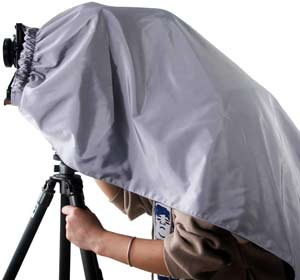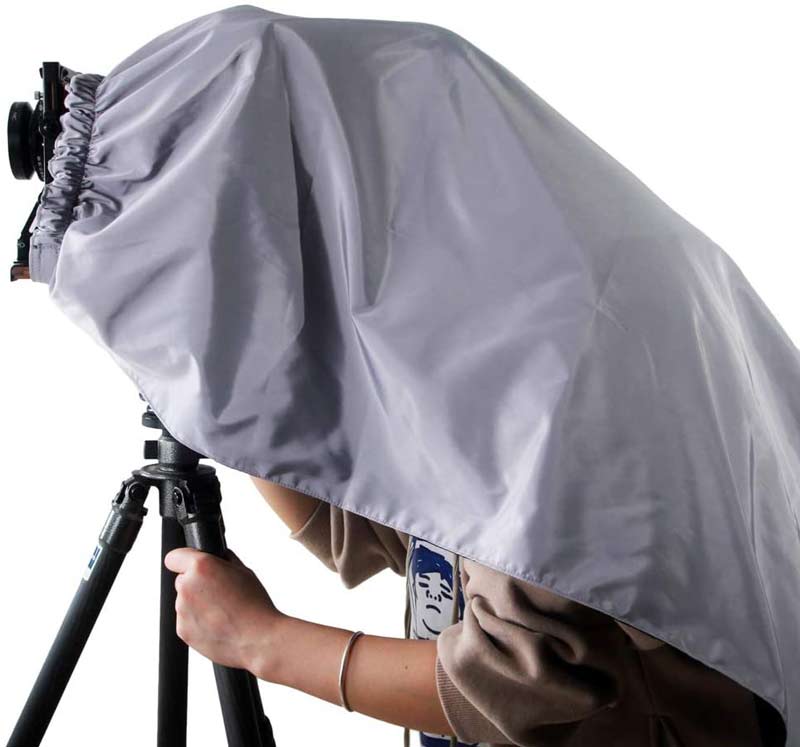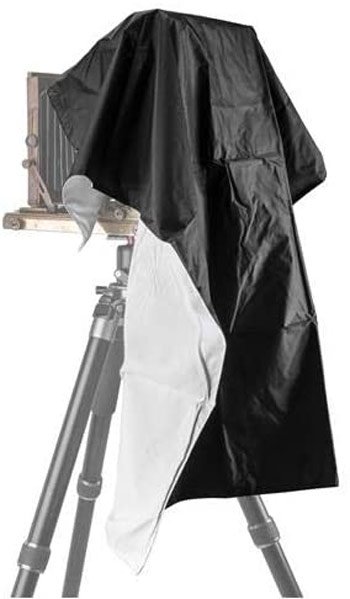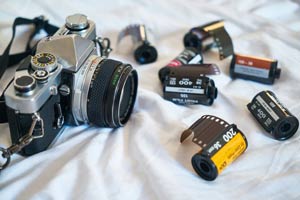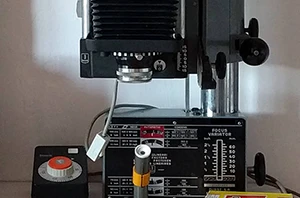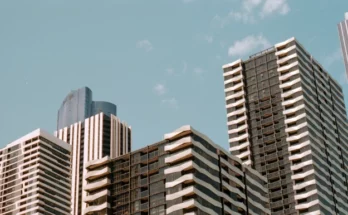What is a dark cloth?
A dark cloth, also called a focusing cloth or hood, is a photographic accessory that is primarily used with large format view cameras. In it’s simplest form, the dark cloth is a piece of light-proof that covers your head and the back of the camera. It eliminates stray light to allow for proper viewing of the relatively dim image on the camera ground glass during framing and focusing.
Dark cloths are also used when viewing LCD monitors in adverse lighting conditions. You can use one with a DSLR or a mirrorless camera and they are a popular film set accessory. Many focus pullers use some form of a dark cloth when pulling focus off a monitor in bright sunlight. Digital imaging technicians (DITs) also commonly use dark tents or cloths to shade their monitors when evaluating exposure or color balance. Astronomers observing the sun also report the benefits of a dark cloth both for improving visibility and for cutting down on the heat by covering their telescopes with the reflecting fabric. Pretty much anyone that needs to closely observe a dim projected image in bright ambient light can benefit from a dark cloth.
Despite the name, dark cloths often come in lighter colors. A popular approach is to have one side black and the other white or silvered. The light side reflects the sun, keeping the temperature under the dark cloth more manageable. In addition, the brighter color is more conspicuous, reducing the chance of someone bumping into you as you are fine tuning your composition. Focusing cloths come in different sizes to match the various camera formats, starting with the smallest 5×4″ press cameras, all the way up into ultra-large format (ULF) territory.
What are the different dark cloth types?
Classic
The most basic dark cloths are simple pieces of lightproof fabric cut to appropriate sizes. Classic dark cloths are readily available or can be easily custom made. As discussed above, more often than not focusing cloths are not all black. The most popular option is a black / silver combination that provides the most heat reflection and visibility. Harrison dark cloths are a popular traditional black/silver option. Red models are also popular, both as a fashion statement and to maximize visibility. If you are getting one custom made, you can pick any color for your dark cloth. As long as the cloth has one black side, the other one is mostly decorative.
Some models come with weights sewn in the corners to prevent the cloth blowing about in the wind. More sophisticated options have touch fasteners sewn along one or more edges to make attaching them to a camera back easy. Many photographers also keep a few clothes pins or clips handy to fasten the ends of the cloth improving shading.
Due to the design of the classic dark cloth, the bottom is always going to be open to some degree, even if you do use attachments or clips. This allows light reflected off the ground to hit your screen. Depending on the conditions, this may or may not interfere with your work. If you find this to be an issue, you might look into more elaborate focusing cloth desings.
Tube type
The second type of dark cloth on the market is known as enclosed or tube type. The typical tube type dark cloth is a large fabric sleeve with two openings, one for the camera back and one for your head. This design significantly cuts down on stray light at the expense of a more stuffy and claustrophobic experience. A popular tube type focusing hood is the Beyond The Zone System (BTZS) model. Some designs like the BlackJacket feature sleeves to allow for the use of a magnifier.
The main issue with an enclosed tube type focusing cloth is condensation, particularly in colder weather. It does not take long for your breath to fog up the cold ground glass. Condensation is an issue with any type of dark cloth, but an enclosed design is inherently more susceptible to it. Some manufacturers like Paramo try to work around it by using breathable technical fabrics with varying degrees of success. A tube dark cloth also makes using a loupe on your ground glass somewhat more of a challenge, although a well designed model should have taken this into consideration.
Finally, due to their close fit, these hoods are also less universal than their classic counterparts. While you can make do with a smaller or larger traditional dark cloth, if you can’t physically fit the tube over the camera back it’s essentially useless. Tube type focusing hoods are also quite limited if you like to cover the camera over long exposures or while waiting for the right light.
How is a dark cloth used?
Using the dark cloth is perhaps the simplest step of the large format photography process. Basically, you cover your head and shoulders with one end, and the back side of the camera with the other. Doing this should be intuitive enough, althout there might be some differences depending on the type of dark cloth and camera you are using.
Typical use
A classic dark cloth is the simplest to use, as there’s no attachments to fiddle with. Drape one end over the camera back, pop your head under and off you go. Do pay attention the where the edge of your dark cloth lies on the camera. You don’t want it draping over the bellows, as this may sag them, causing vignetting or damage, especially with weighted cloths. You may need to keep a couple of clips to fasten the edge of the fabric onto the camera body. Once you have you shot framed, focused and locked, you can tuck away the focusing cloth before inserting the film holder.
With older cameras, like many large format setups out there, light leaks can sneak up on you. A good preventive practice, especially with long exposures, is to cover the camera with the dark cloth during exposure, including the back. This significantly reduces the risk of a surpirse light leak from a bellows pinhole or an older film holder ruining your shot. As discussed above, make sure the cloth is not pushing on the bellows or obscuring the field of view of the lens in any way.
To attach or not?
Some photographers use touch (hook and loop) fasteners to attach the dark cloth to the camera. You can have hook part sewn along the edge of the dark cloth and place self adhesive loop strips on the camera body. This will enable quick and secure attachment and removal of the focusing cloth. It’s not advisable to leave the focusing cloth on the camera during an exposure, even if it does not impend film holder placement. The increased surface area of the camera with an attached focusing cloth makes the system more susceptible to wind vibration or even getting knocked over by a rogue gust.
Some more elaborate focusing cloth designs offer attachment mechanisms on one or both ends. The most popular type of attachment uses a drawstring around the perimeter of the camera-side opening. The dark cloth is placed around the camera back and secured tight using the drawstring. Other models use velcro or magnets to achieve the same result.
Do you need a dark cloth?
Using a dark cloth is a personal preference as much as anything else when it come to photographic gear selection. Some photographers would not go out without one, while others swear by fresnel lenses and pop-up hoods or make do with adapted pieces of clothing. If your camera has a extra-bright ground glass like a Maxwell or Boss, you may well not need a focusing cloth to see the image in most situations.
A dark cloth is a cheap and easily obtainable accessory, especially compared to large format film and equipment. Therefore, a decision to forego one is usually dictated by factors other than cost. Most dark cloths are bulky affairs, and if you are traveling light it might not make the cut. In such cases, it might be prudent to look for a dual use alternative, like a black T-shirt or a lightweight rain jacket.
On the other hand, if bulk and weight are not a factor, a focusing cloth is nice to have even if you don’t use it all the time. Beyond it’s primary function, a dark cloth can be useful in other ways, too. You can use it to shield your camera or yourself from the sun or rain. Many large format landscape photographers would set up a shot and then wait, sometimes for hours, for the right light or clouds. You can use the dark cloth to cover the camera during the wait to minimise dust or dew.
On the practical end, a focusing cloth makes nice padding in your gear bag or case. You can pad your seat for those long exposures or use it as a work mat for delicate tasks in the field. A dark cloth can also provide a shaded place to swap a roll of film or unjam a camera in an emergency, albeit its no substitute for a proper changing bag.
What are dark cloth alternatives?
Since the task achieved by the focusing cloth is fairly simple, the opportunities for improvisation when one is not available are farily broad. Essentially, anything you can use to shade the focusing screen while still being able to look at it will do.
Dark clothing
In a pinch, pretty much any darker colored piece of clothing can be used as an impromptu dark cloth. Rain jackets, scarves, shirts or T-shirts can all be used to shade yourself and your camera with varying degrees of success. A black round neck T-shirt is the “industry standard” and some photographers use them as their main dark cloth. You’ll be better off with a larger size.
With a 5×4 camera, you can loop the head opening around the back of the camera eliminating stray light. With 5×7 or 8×10, you might have to go the other way around, draping the waist portion of the T-shirt on the camera and popping your head in through the head hole. Convenietly, you can also use the sleeves to put your hands in, for example to use a magnifier.
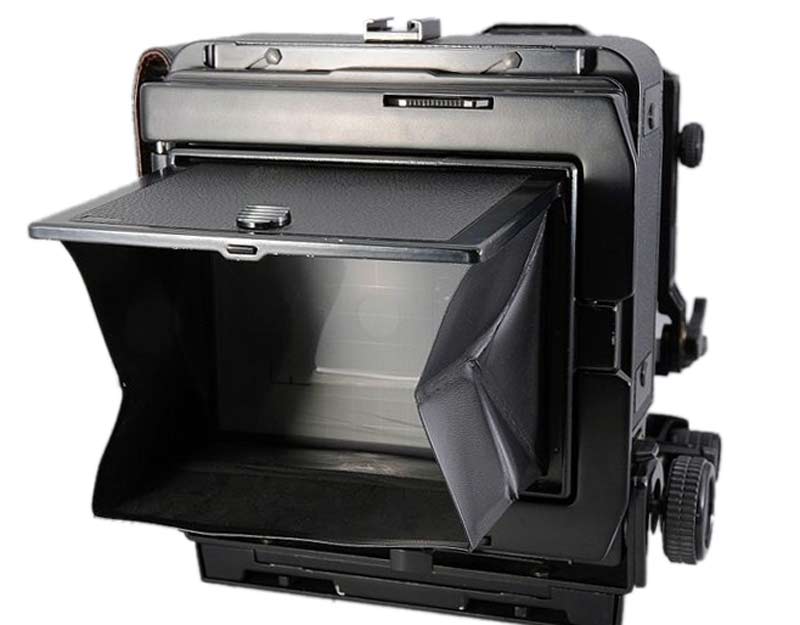
Fold-out viewing hoods
Many field cameras come with fold-out viewing hoods, which operate much like a medium format collapsible waist level finder. As an example, the Toyo 45A II 4×5 field camera usually comes with the fold-out hood pictured above. Most large format camera manufacturers like Linhof, Cambo, Horseman and Chamonix offer those hoods, which also double as ground glass protection covers when folded.
These hoods provide limited shading, but in combination with a fresnel focusing screen it might just be enough for you. A fold out hood is a good solution if you are packing light, as it’s one of the slimmest shading solutions for ground glass viewing. The restricted access to the ground glass the fold-out hood provides may make the use of a magnifier challenging. If you are shopping for a magnifier to use with a fold-out hood, consider a longer model like this Peak model.
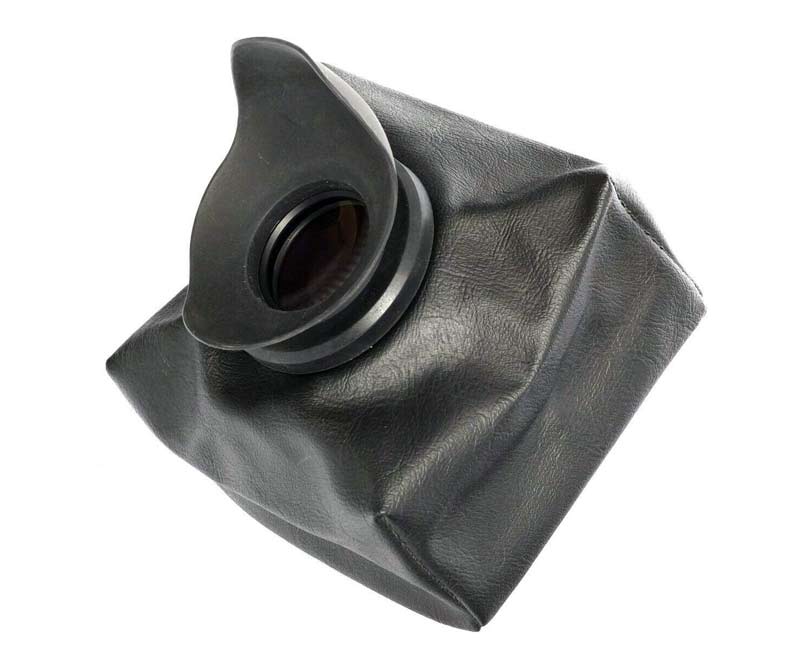
Flexible viewing hoods
An interesting blend between fold-out hoods and binocular viewers, the flexible hoods are another viable alternative to a dark cloth. Comprised of what is essentially a bag bellows with a viewing port, the device offers a convenient way of working with a large format camera. Completely blocking out stray light, a flexible focusing hood provides optimal viewing without the need to cover your head. This makes the device particularly useful in very hot or cold climates, where hear or condesation might be an issue under the dark cloth.
A flexible focusing hood does not present a rectified image like a reflex hood, but it’s lighter and takes significantly less space. Compared to a fold-out hood, this device offers much more comprehensive shading resulting in a better viewing experience. While being similarly easy to pack, the flexible viewing hood does not provide the protective features of a fold-out model. Currently, flexible focusing hoods are offered only by Cambo and Toyo, with the Cambo model offering a built-in magnifier.
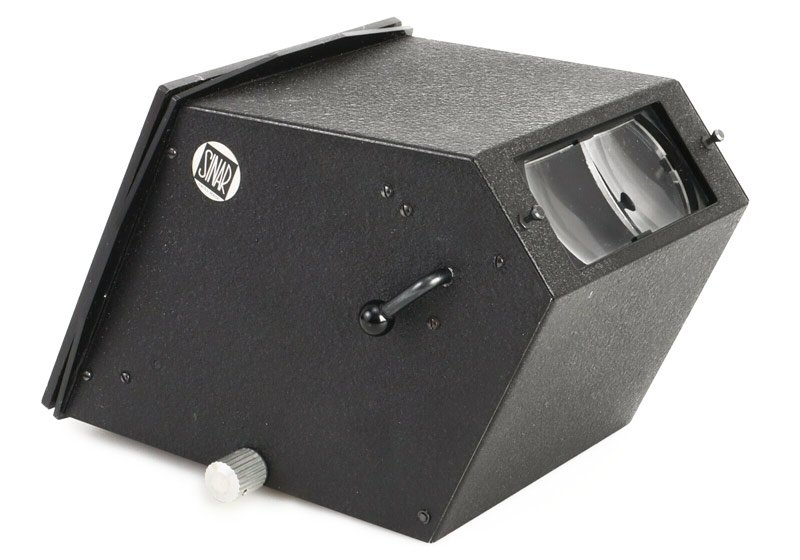
Reflex viewing hoods
Reflex hoods are on the more sophisticated end of the focusing cloth alternatives. These are rigid hoods that have a mirror inside, providing a right side up image of the ground glass. Like using a waist level finder on a medium format camera, the image in the reflex hood will still be reversed left to right, as there is no prism to rectify this like in an SLR. There are monocular and binocular reflex viewers.
The heaviest and most expensive of the large format viewing devices, the reflex hoods are mostly confined to a studio environment. Some manufacturers aim to remedy that by utilizing folding designs, but the weight of the devices is still considerable, compared to a simple flip-out hood.

